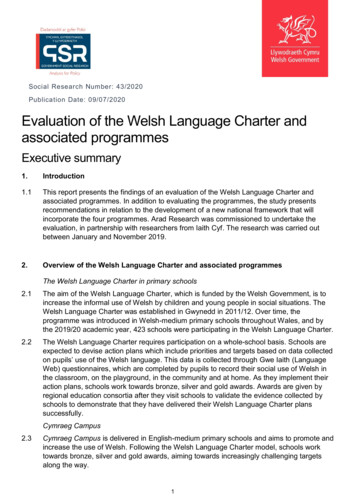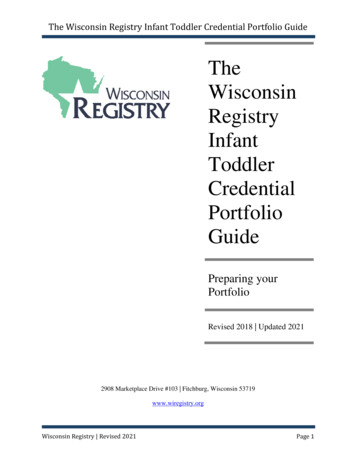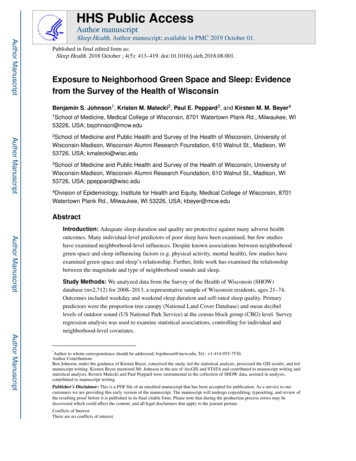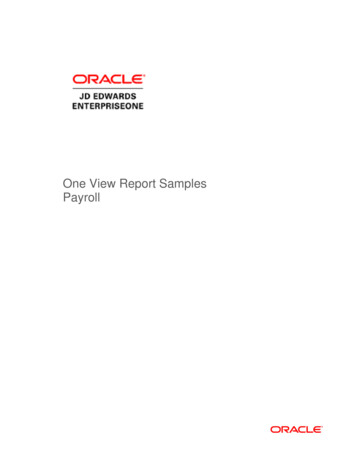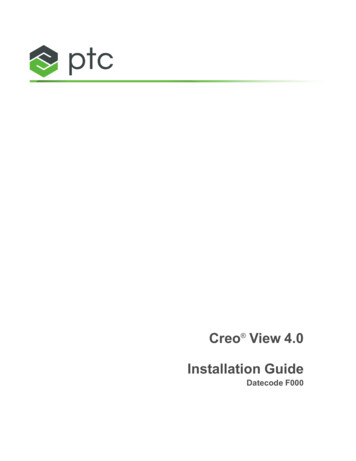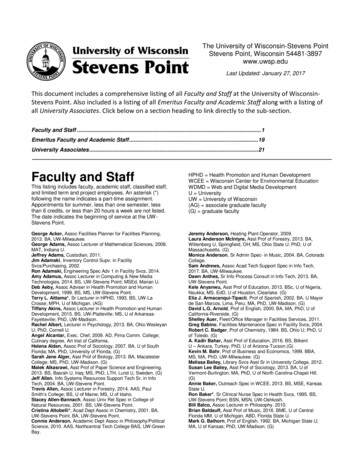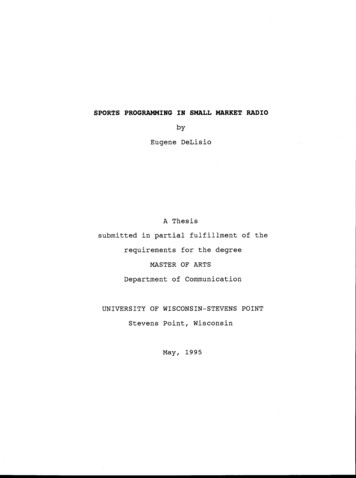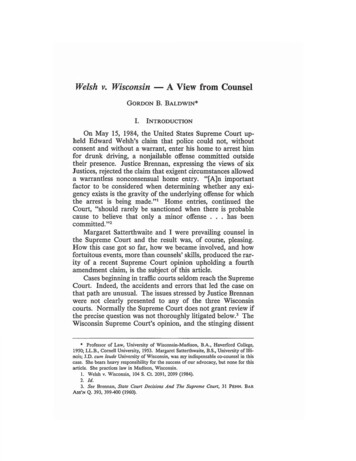
Transcription
Welsh v. Wisconsin — A View from CounselG ordon B. B a l d w in *I.In troductionOn May 15, 1984, the United States Supreme Court up held Edward Welsh’s claim that police could not, withoutconsent and without a warrant, enter his home to arrest himfor drunk driving, a nonjailable offense committed outsidetheir presence. Justice Brennan, expressing the views of sixJustices, rejected the claim that exigent circumstances alloweda warrantless nonconsensual home entry. “ [A]n importantfactor to be considered when determining whether any exi gency exists is the gravity of the underlying offense for whichthe arrest is being made.” *1 Home entries, continued theCourt, “ should rarely be sanctioned when there is probablecause to believe that only a minor offense . . . has beencommitted.” 2Margaret Satterthwaite and I were prevailing counsel inthe Supreme Court and the result was, of course, pleasing.How this case got so far, how we became involved, and howfortuitous events, more than counsels’ skills, produced the rar ity of a recent Supreme Court opinion upholding a fourthamendment claim, is the subject of this article.Cases beginning in traffic courts seldom reach the SupremeCourt. Indeed, the accidents and errors that led the case onthat path are unusual. The issues stressed by Justice Brennanwere not clearly presented to any of the three Wisconsincourts. Normally the Supreme Court does not grant review ifthe precise question was not thoroughly litigated below.3 TheWisconsin Supreme Court’s opinion, and the stinging dissent Professor of Law, University of Wisconsin-Madison, B.A., Haverford College,1950; LL.B., Cornell University, 1953. Margaret Satterthwaite, B.S., University of Illi nois; J.D. cum laude University of Wisconsin, was my indispensable co-counsel in thiscase. She bears heavy responsibility for the success of our advocacy, but none for thisarticle. She practices law in Madison, Wisconsin.1. Welsh v. Wisconsin, 104 S. Ct. 2091, 2099 (1984).2. Id.3. See Brennan, State Court Decisions And The Supreme Court, 31 P enn . BarA ss’n Q. 393, 399-400 (1960).
624MARQUETTE LAW REVIEW[Vol. 68:623by Justice Abrahamson, pointed the case to our highestcourt.45II.T he T a l e U nfoldsA.Factual BackgroundThe facts are commonplace. Edward Welsh was drivinghome a little after dark on a rainy April evening in 1978. Awitness, who happened to be the University of Wisconsin’s no table crew coach, Randy Jablonic, saw the Welsh car swerveacross oncoming traffic and stop in an open field. Jablonicstopped, too. Jablonic later testified that he talked to thedriver, Edward Welsh, and refused Welsh’s pleas for a ridehome. Welsh, Jablonic concluded, was either intoxicated orsick “ or not very much in possession of his faculties.” Welshthen abandoned his car and walked off into the night. Policearrived within a few minutes and talked to Jablonic. Theylater testified that Jablonic unambiguously stated that the ab sent driver was “ very obviously intoxicated.” Police tracedthe car to Edward Welsh, who lived within half a mile of thefield where it was abandoned, and the three policemen droveto the Welsh residence. They entered, claiming they were in vited by Mrs. Welsh and by one of her daughters, a girl thenjust seventeen. They arrested Edward Welsh as he lay nakedin his upstairs bedroom, ordered him to dress, took him on thefour mile journey to the Madison police station and asked himto take the standard breath test for alcohol. Welsh, who hadtaken a drink or so after returning home, refused. Under Wis consin’s Implied Consent Law an unreasonable failure to takea blood alcohol test justifies suspension of driving privileges?The arresting officer therefore issued a citation for drivingwhile intoxicated, and Welsh’s refusal to take a blood alcoholtest was reported to the Department of Motor Vehicles.The case was routine. The Department of Motor Vehiclesissued a notice of their intention to suspend Welsh’s license.Because records disclosed a prior arrest for driving while in toxicated, the District Attorney also substituted a criminal4. State v. Welsh, 108 Wis. 2d 319, 321 N.W.2d 245 (1982), cert, granted, 459 U.S.1200(1983).5. Wis. Stat . § 343.305 (1983-84). Amendments since 1978 are not relevant to thecase.
1985]VIEW FROM COUNSEL625complaint for the citation, a procedure commanded for sec ond offenders. Welsh now faced two charges. First, the crim inal charge for a second offense of operating a motor vehiclewhile intoxicated6 and second, a civil charge for refusing ablood alcohol test which could lead to the suspension of hisdriver’s license. The criminal charge required a trial; the civilcharge allowed Welsh a hearing to determine whether his re fusal to take a blood alcohol test was “reasonable.”Welsh was represented by Archie Simonson of Madison,an experienced practitioner who, until his defeat in a recallelection in 1977, served as a Dane County Circuit Judge. Si monson promptly challenged both charges on the ground thatthere was no justification for the warrantless in-house arrest inthat everyone in the home denied giving the police consent toenter. Welsh’s defenses rested on Wisconsin law, which pro vides that jurisdiction may not be based upon an unlawfularrest,7 and upon the fourth and fourteenth amendments.Wisconsin law explicitly commands that a valid arrest precedea blood alcohol test.8 It therefore was not necessary to invokethe exclusionary rule. The defense motions focused upon anonconsensual entry, and upon the failure of the police toshow “ hot pursuit.” A separate evidentiary hearing was re quired for both the criminal and civil charges.The State’s response was obvious: namely that the officershad consent to enter, and that even if consent were lacking,exigent circumstances excused the normal rule that arrests inthe home require warrants. Furthermore, the State argued,had the police delayed their entry, evidence of intoxicationwould have disappeared. Nobody raised two points thatshould have been equally clear: that at the time of the arrestthe police had no probable cause to believe Edward Welshwould face criminal charges; and that it was debatablewhether a Wisconsin judge could have issued an arrest war rant for a first offender (rather than a summons).96. Wis. Stat . § 346.63 (1983-84). Amendments since 1978 are not relevant to thecase.7. The principle was established in Laasch v. State, 84 Wis. 2d 587, 267 N.W.2d278 (1978).8. Scales v. State, 64 Wis. 2d 485, 494, 219 N.W.2d 286, 292 (1974).9. See Wis. Stat . § 968.04(2)(b) (1983-84).
626MARQUETTE LAW REVIEWB.[Vol. 68:623The Wisconsin CourtsThe cases were assigned to Judge Buenzli. However,Judge Buenzli confronted a heavy docket, and he was plan ning on retirement toward the end of 1978. He didn’t reachthe Welsh cases, so they were routinely assigned to his succes sor, Judge Boll. Judge Boll came to the bench with an equallyheavy load, and drunk driving cases didn’t command priority.Not until February 1980 did he schedule hearings on the pre trial motions on the criminal charge. Edward Welsh, his twostepdaughters and his wife dutifully appeared and were readyto testify. The most important witness was the stepdaughterwho answered the door the night that police arrived at theWelsh residence. Her sister and her mother were prepared toconfirm her claim and confirm that no one gave the policepermission to enter. Police Officer Daley, on the other hand,would testify that he had proper consent to enter. Unfortu nately the young assistant district attorney handling the casewas on vacation and his substitute was unprepared. JudgeBoll declined to hear testimony from the Welsh family. Hedismissed the case, and despite defendant’s objections statedthat the State could begin again. The State promptly filed andserved a new criminal complaint. Simonson repeated his mo tions, and the file grew larger. Ironically, the delays gaveWelsh’s counsel the benefit of a better argument. In April1980 the Supreme Court issued its opinion in Payton v. NewYork holding that a warrantless nonconsensual entry into asuspect’s home to make a routine felony arrest violated thefourth amendment. The Court explicitly left open whetherexigencies might excuse the warrant requirement, and implic itly invited petitions for review on the scope of the exigentcircumstances doctrine.Another evidentiary hearing on the criminal charges wasscheduled for July 14, 1980 before Dane County Circuit JudgeMark Frankel. The State was now ready, but unfortunately acritical witness, the stepdaughter who had met the policemenat Welsh’s door, had left home to marry. She was living inCalifornia and could not return. The other stepdaughter hadalso left the Welsh home and was unavailable. Judge Frankel*10. 445 U.S. 573 (1980).
1985]VIEW FROM COUNSEL627recognized that it was impossible to rule on the consent issuewithout the key witnesses, and he therefore suggested that ifthe State could establish the presence of exigent circumstancesor hot pursuit the consent issue would become irrelevant. Onthose points the court heard testimony from the arresting of ficer, Randy Jablonic, and Mrs. Welsh. The thrust of Simon son’s attack was that too much time had elapsed between thepolice discovery of the abandoned car and their entry into thehouse. The judge was unconvinced. Judge Frankel found thearrest justified by the exigent circumstances doctrine and bythe “reasonably hot pursuit.” He rejected an analogy to Payton v. New York on these grounds. In September 1980 JudgeFrankel held a hearing on whether Welsh’s refusal to take ablood alcohol test was reasonable. He stated he was bound byhis prior rulings and despite the additional testimony of Ed ward Welsh, concluded that the refusal was not justified.After losing the motions Welsh still faced the two differentcharges: the criminal charge arising from a second arrest fordriving while intoxicated, and the civil forfeiture involving theloss of driving privileges. Simonson appealed to the Wiscon sin Court of Appeals on the civil forfeiture issue, and thereprevailed. On May 26, 1981 Judge Paul Gartzke, actingalone, ruled that Welsh was unlawfully arrested.11 JudgeGartzke rejected application of the exigent circumstances ex ception and instead balanced the need to enter a dwelling topreserve evidence against the seriousness of the invasion. Thejudge stated that “ the need to search defendant’s home to pre serve evidence was low compared to the interest invaded bythe search.” He remanded the case to determine whether en try was gained by consent.The State appealed. Perhaps their chief motive was toclarify the power of a single court of appeals judge to rule onappeals from orders suspending driving licenses. The Statealso appealed the ruling that the warrantless arrest in thehome was not justified by exigent circumstances. Seventeenpages o f its brief focused on that issue. State v. Welsh wasargued on March 1, 1982 and the Wisconsin Supreme Courtcame down with its opinion on July 2.12 The delay strongly11. The decision is unreported. It should be.12. 108 Wis. 2d 319, 321 N.W.2d 245 (1982).
628MARQUETTE LAW REVIEW[Vol. 68:623suggests that the case was difficult. The tone of Justice Abra hamson’s dissent, joined by'Justice Heffernan, suggests thatthe 4-2 decision prompted vigorous debate in chambers.13III. A pp e a l T o T he U n ited St a t e s Suprem e C o urtA.The Petition for CertiorariAfter reading the opinion that summer, my view, sharedby several colleagues, was that the majority opinion of theWisconsin Supreme Court was inconsistent with fourthamendment law. Others, including Margaret Satterthwaitewho had just completed a clerkship with Justice Heffernan,saw the opinion as a calamity. Its implications were indeedthreatening. Could police forcibly enter a home if a persua sive eyewitness reported that an occupant was recently drivingwhile intoxicated? Anyone could imagine the consequences ofsuch a license.The decision was referred to the New York headquarterso f the American Civil Liberties Union. About a week beforethe deadline for filing a timely petition for certiorari, welearned that the national A C L U had no interest in taking thecase. We never knew their reasoning. Perhaps the prospect ofrepresenting an alleged drunk driver was not appealing, orperhaps they thought the Wisconsin decision correct. TheWisconsin Civil Liberties Foundation disagreed, and attorneyCharles F. Kahn, Jr., subsequently wrote a splendid amicusbrief challenging the Wisconsin ruling.Margaret Satterthwaite and I were troubled by the conse quences that might flow from the Wisconsin Supreme Court’slicense to enter homes, so we talked with Mr. Simonson andasked him whether he was petitioning for review in the UnitedStates Supreme Court. His clients lacked funds, and he hadalready spent inordinate time on the case, so he asked me if Iwas interested. O f course I was, and the assurance of Mar garet’s aid made my decision easy. Simonson promptly con ferred with his client, who graciously invited us to take over.The public defender, then David Niblack, agreed that the is 13. Justice Ceci did not sit on the case. If one of the majority had switched, ChiefJustice Beiifuss for example, the vote would have been a tie, no opinion would have beenissued and Judge Gartzke’s opinion would have stood.
1985]VIEW FROM COUNSEL629sue was important and indicated that, if Edward Welsh quali fied for assistance through the public defender program, thatoffice would pay expenses, within statutory limits. Because Iwas already on the University of Wisconsin’s payroll and wasthen Chairman of the Public Defender Board, I agreed toserve without a fee. However, Margaret, who had taken em ployment in Racine, received the standard, although pitiful,statutory rate of 25 per hour.14The critical dilemma was what to include in the petitionfor certiorari. Two issues were obvious: whether there wassufficient probable cause, and whether a warrantless arrestwas justified in the circumstances. We argued more about thefirst. I was reluctant (Margaret will doubtless say stubbornlyreluctant), to include this in our petition. The issue had beendecided in the Wisconsin Supreme Court, but I thought it dis tracting. Moreover, the arresting officers had probably actedin good faith and I feared that the Court might use good faithto justify a home entry.15 Besides, there was evidence on therecord that the arresting officer knew that Edward Welsh wasno teetotaler. The officer had arrested Welsh in his home sev eral weeks before the April 1978 event on a disorderly con duct charge, unrelated to driving. Welsh, he said, was thendrunk. On balance, despite supporting arguments raised inJustice Abrahamson’s dissent, I thought that a challenge onprobable cause grounds would fail. Perhaps if we had debatedlonger Margaret would have prevailed, but we were pressedfor time.The petition for certiorari drafted by Margaret Satterthwaite was simple. It consisted of three pages of facts andone page of law. We relied on only two cases, Payton v. NewYork,1617which explicitly left open the meaning of the exigentcircumstances doctrine, and Camara v. Municipal Court,1'1where a warrant was required in a civil case. Fourth amend ment case law is Uttered with statements about the sanctity ofthe home, and we believed it unnecessary to belabor the obvi 14. Wis. Sta t . § 977.08(4m) (1983-84).15. On January 11, 1982, the Supreme Court granted review o f Illinois v. Gates, acase in which the State of Illinois argued for a good faith exception to the exclusionaryrule. See infra note 21.16. 445 U.S. 573 (1980).17. 387 U.S. 523 (1967).
630MARQUETTE LAW REVIEW[Vol. 68:623ous. We focused on a point mentioned by the WisconsinSupreme Court, but not discussed by the majority: that policeofficers knew Welsh was being arrested for a nonjailableoffense.In retrospect we should have cited United States v. Vasquez,li wherein Justices Brennan, White and Marshall dis sented and urged the Court to consider an exigentcircumstances claim. Justice Stevens’ concurrence indicatedhis receptiveness to hearing an exigent circumstances case ifthe issue was more sharply presented. We decided not to clut ter the short petition with more references. The issue uponwhich we sought review was simply stated. The majority anddissenting opinions of the Wisconsin Supreme Court wereclear and sharply focused on the fourth amendment. A shortpetition would make the work of the Justices, and their clerks,easier.1819Edward Welsh, meanwhile, was much engaged. His trialon the criminal charge was held before a Dane County jury,which in January 1983 reached a verdict, after hearing thetestimony of the arresting officer, of driving while intoxicated.Welsh received a five day jail sentence, which was stayedpending appeal. Indeed, all further proceedings were stayedpending action by the United States Supreme Court. On No vember 9, 1982 the Court directed the Attorney General ofWisconsin to file by December 9 a response to the Welsh peti tion. This was a good sign for petitioners— the Court rou tinely dismisses many petitions for review without hearing theother side. Now the burden fell on the Attorney General ofWisconsin, who assigned the case to one of his ablest younglawyers, Stephen W. Kleinmaier, who had argued the case inboth the Wisconsin Court of Appeals and the Wisconsin18. 638 F.2d 507 (2nd Cir. 1980), cert, denied, 454 U.S. 975 (1981).19. We spent as much time reviewing the Supreme Court Rules and obtaining gui dance on the forms and procedure recommended in Stern & G ressman, SupremeCourt P ractice (5th ed. 1978), as we did on the substantive research. Although rulesare relaxed for petitions in forma pauperis, see Sup . Ct . R. 46, as ours was, we meticu lously honored the procedures for paid cases except the requirement that the petition beprinted. The recent purchase of a simple Olivetti ET231 memory typewriter immenselyeased our task. Margaret is a gifted writer and a sharp thinker. To her goes the creditfor a sharp and eventually persuasive petition. Roberta Marcus, who typed the finalproduct, was additionally valuable. She can spot a missing comma from thirty paces.
1985]VIEW FROM COUNSEL631Supreme Court. Coincidentally, Stephen, like Margaret, wasa former law clerk for Justice Heffernan.The Attorney General’s nine page response was coupledwith a 176 page appendix, the purpose of which was todemonstrate that no one had argued in the state court pro ceedings that the police authority to enter was limited becausethe suspected offense was only punishable by a civil forfeiture.This, of course, was exactly the response we anticipated. Wewere mildly comforted that Simonson’s responding brief inthe Wisconsin Supreme Court noted that when they arrestedhim police did not know that Welsh had a prior conviction.That point, however, was only made in claiming that policelacked probable cause to make an arrest. The Attorney Gen eral’s brief discussion on the exigent circumstances doctrinesuggested that the issue turned on the sufficiency of the evi dence, and that such evidentiary issues are not ordinarily re viewed by the United States Supreme Court.We were forced to reply quickly if we were to be heard.The Court could have acted immediately and was not obligedto wait for replies. Hence we drafted and mailed our six pagereply on December 17, 1982. We relied heavily upon SupremeCourt Rule 21.1(a), which states that “ the question presentedwill be deemed to compromise every subsidiary question fairlyincluded therein.” From the beginning of the case, we argued,a fourth amendment claim was persistently advanced.“ Quintessentially the question presented and ‘fairly includedtherein,’ is the sort of emergency . . . which will justify a war rantless non-consensual entry into the home.” Furthermore,we said, the State of Wisconsin and its Supreme Court hadrelied upon the traffic arrest statute,20 and that statute specifi cally concerns arrests punishable only by civil forfeitures. Allhands agreed, we said, that the exigent circumstances doctrinewas forcefully argued in all the state courts.Having done all required, we waited and worried. I re mained convinced that our case was cert-worthy and would fitneatly with other cases on the Court’s docket. In January20. Wis. Stat . § 345.22 (1983-84).
632MARQUETTE LAW REVIEW[Vol. 68:6231982 the Court granted review in Illinois v. Gates.21 That casegave the Court an opportunity to consider a “ good faith” ex ception to the exclusionary rule, and the conventional wisdomwas that a majority would sustain police who scrupulouslyobeyed a technically deficient warrant. Our cases did not in volve warrants or the exclusionary rule, and hence would al low the Court to confirm fourth amendment values withoutaddressing a controversial doctrine. On the docket also werecases involving warrantless searches of a package,22 an auto mobile,23 a shoulder bag carried by an arrestee,24 and a drunkdriving case.2S The latter considered whether evidence of adefendant’s refusal to take a blood alcohol test could be usedat trial. O f special interest were a pair of cases involving themodem application of the “ open fields” doctrine, namelywhether warrantless entries upon private land were permittedin view of the more recent focus on legitimate expectations ofprivacy. The Court granted review in Oliver v. United Stateson January 24, 1983,2628and later in Maine v. Thornton.21 The7Court might, I thought, allow warrantless entries onto openfields, but hold a warrantless home entry was forbidden. TheCourt in January also agreed to hear Michigan v. Clifford,2* aninteresting case involving a warrantless home entry by an ar son investigator six hours after the blaze was extinguished.However, the Clifford home, in contrast to Welsh’s, was unoc cupied. By mid-February nearly all the petitions filed contem poraneously with Welsh had been acted upon.The Supreme Court’s telephone answering service is un commonly helpful and unfailingly gracious. A t their finger tips the Clerk’s office has a computer which will give callersthe latest orders. I habitually took advantage of their courtesyon every order day from January 10, 1983 onward. I was fi 21. The petition for certiorari was granted in 454 U.S. 1140 (1982). Ultimately theCourt refused to address the good faith exception in Gates, ruling that it had not beenproperly raised in the Illinois courts. See Illinois v. Gates, 462 U.S. 213 (1983).22. Illinois v. Andreas, 103 S. Ct. 3319 (1983).23. Michigan v. Long, 103 S. Ct. 3469 (1983).24. Illinois v. Lafayette, 103 S. Ct. 2605 (1983).25. South Dakota v. Neville, 459 U.S. 553 (1983).26. 104 S. Ct. 1735 (1984).27. 104 S. Ct. 1735 (1984).28. 104 S. Ct. 641 (1984).
VIEW FROM COUNSEL1985]633nally rewarded on February 22.29 The Court had granted re view that morning in two in forma pauperis cases, ours andSegura v. United States.30 I talked with Segura’s counsel todetermine whether our cases were sufficiently alike to justifyan exchange of briefs. They were not. Margaret and I nowhad to prepare ours. We knew that the Court’s argumentdocket was full for the remaining weeks in the 1982 term andthat we could probably expect a reasonable extension of thenormal forty-five day briefing period.31 Indeed, both sidesasked for and received modest extensions of time in the brief ing schedule. Quite aside from the demands of counsels’schedules, the delay gave both sides an opportunity to con sider all the cases coming down in the 1982 term.B.Preparing The BriefCounsels’ first task was to agree on the contents of a jointappendix required by Supreme Court Rule 30. The procedurewas simple. Margaret and I rooted through the official rec ord, noted the parts we thought helpful and relevant, and thenasked Stephen Kleinmaier if he wanted to include anythingmore. He did suggest a few dozen more pages, primarilytaken from the transcript of the evidentiary hearings. We hadno disagreements on the contents. The joint appendix must beprepared to the standards commanded by the SupremeCourt’s unique rules.32 This was a tedious chore because pho tocopies are not permitted, and without the extraordinarilyversatile W ANG word processors harbored at my university,and their uncommonly talented operators, the job would havetaken longer than the forty-five days commanded by the rules.Nearly half of the 213 page joint appendix consisted of theWisconsin Court of Appeals and Supreme Court opinions. Ipray that the next revision of the Supreme Court rules willallow photocopies of at least the printed opinions of the courts29. See 459 U.S. 1200 (1983).30. Id.31. Justice White’s comments on the unusually heavy 1982 Term docket are re ported in 51 U.S.L.W. 3191 (U.S. Sept. 28, 1982).32. Supreme Court Rule 33 commands 11 point type for text, 9 point for footnotes,on 6 1/8” x 9 1/4” pages with margins of at least 3/4” on all sides. The color of thecovers is also directed, and page limits are imposed.
634MARQUETTE LAW REVIEW[Vol. 68:623below. Typing them over was tedious, invited copy errors,and was wasteful.Margaret and I debated every word in our brief. Researchwas not difficult— we both had a pretty fair grasp of fourthamendment law, and we knew that the Court was thoroughlyfamiliar with it too, inasmuch as the current Court has mademost of it recently. The views of all except Justice O ’Connorare recorded in their opinions. In United States v. Watson33and Payton v. New York34 there are accurate reviews of fourthamendment history, so we did not feel obliged to offer an his torical review. Among the ten recent law review articles onhome arrests there was a nice one published in the ArizonaLaw Review in 1981.35 We thought it politic to include thatreference for the benefit of Justices Rehnquist and O ’Connor,two Arizona natives. We found no cases involving blood testobtained via a warrantless home arrest, although Schmerber v.California3637 allowed a compulsory test in a hospital a fewhours after an auto accident. Both state and lower federalcourts had, however, handed down many decisions evaluatingexigent circumstances claims.Our claim rested on two grounds: first, at common law theexigent circumstances doctrine applied only to arrests for ma jor crimes; and second, it is unreasonable for law enforcementto invade the home for minor offenses. Such invasions couldnot be justified because the immediate arrest of such an of fender is less important than security of people against unrea sonable searches and seizures. Our principal problem was todecide how to organize our presentation. We argued the alter natives. Margaret’s arguments were most persuasive. If thebest briefs are the product of robust debate, ours would begood indeed.Justice Robert Jackson’s warning in McDonald v. UnitedStates31 was helpful. Counsel finding a relevant Jackson opin ion is well advised to use it— his graceful style enriches and33. 423 U.s. 411 (1976).34. 445 U.S. 573 (1980).35. See Note, Exigent Circumstances fo r Warrantless Home Arrests, 23 A riz . L.R ev . 1171 (1981), cited in Welsh v. Wisconsin 104 S. Ct. 2091, 2099 n.13 (1984).36. 384 U.S. 757 (1966).37. 335 U.S. 451, 457 (1948)(Jackson, J., concurring).
1985]VIEW FROM COUNSEL635informs. McDonald involved a forced entry to break up anumbers game. Police should not enter, he said:“ [W]hile the enterprise of parting fools from their money . . .is one that ought to be suppressed, I do not think that its sup pression is more important to society than the security of thepeople against un-reasonable searches and seizures.” 38Margaret was more certain than I that we had to arguethat under no circumstances would a warrantless home entrybe permitted to take a blood alcohol test for a minor offense. Idon’t like absolute arguments, and I don’t think the SupremeCourt’s majority does either. However, some common lawprecedents favored the absolute rule, and I decided we werebound to make that claim for our client. It was more likely,we thought, that the Court would be receptive to a totality ofcircumstances approach to the exigent circumstances doc trine.39 We identified three somewhat different approaches tothe doctrine in the lower courts. The first, a somewhatmechanical, if not uncertain, balancing of seven factors, wasadvanced by the District of Columbia Court of Appeals inDorman v. United States.40 The second was represented by agroup of mostly California cases which simply defined an exi gency as “ an emergency situation requiring swift action toprevent imminent danger to life or serious damage to prop erty, or to forestall the imminent escape of a suspect or de struction of evidence.” 41 A third line of cases simply directedcourts to focus on the facts, but included examination ofwhether or not there was time to get a warrant.42 We weretroubled by Professor LaFave’s treatise, cited by the Wiscon sin Supreme Court, which urged a presumption favoring war rantless entries where there was an ongoing policeinvestigation.43 The Court likes Professor LaFave’s work, as38. 335 U.S. at 460.39. The totality of circumstances rule was adopted in Illinois v. Gates, 462 U.S. 213(1983).40. 435 F.2d 385 (D.C. Cir. 1970).41. People v. Ramey, 16 Cal. 3d 263, 545 P.2d 1333, 127 Cal. Rptr. 629 (1976),cert, denied, 429 U.S. 929 (1976). See also State v. Canby, 252 S.E.2d 164 (W. Va.1979).42. See generally Donnino & Girese, Exigent Circumstances fo r a WarrantlessHome Arrest, 45 A lb. L. R ev . 90, 109-10 (1980).43. W. L aF ave , Search A nd Seizure 391-92 (1978).
636MARQUETTE LAW REVIEW[Vol. 68:623do I, although my admiration for one of Wisconsin LawSchool’s distinguished graduates is tempered when his argu ments do not favor a client. The LaFave presumption, more over, would swallow the general rule against allowingwarrantless nonconsensual entries.44Entries to prevent imminent destruction of evidence arecommonly permitted by lower federa
Justice Brennan, expressing the views of six Justices, rejected the claim that exigent circumstances allowed . four mile journey to the Madison police station and asked him to take the standard breath test for alcohol. Welsh, who had . the District Attorney also substituted a criminal 4. State v. Welsh, 108 Wis. 2d 319, 321 N.W.2d 245 (1982 .
